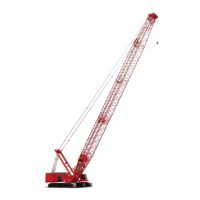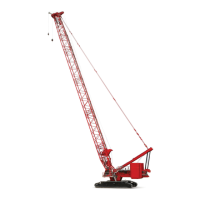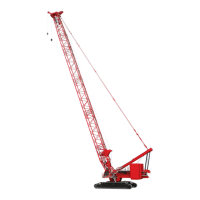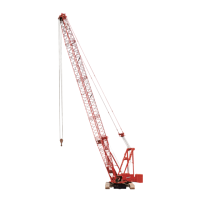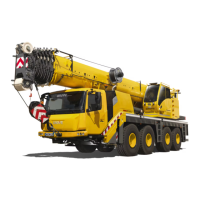Manitowoc Published 10-09-2020, Control # 259-06 5-9
MLC80A-1/MLC90A-1/MLC100A-1/MLC100-1 SERVICE/MAINTENANCE MANUAL HOISTS
DRUM 3
See Figure 5-6 and Figure 5-7.
Overview
The hydraulic circuit for Drum 3 consists of one
independently controlled 107cc rotary group (Pump A) of the
main pump, an electrically-operated directional control valve,
and a 107cc variable displacement motor with a single-sided
holding valve and internal relief valve.
The control signals to these hydraulic elements are
determined by the CCS, which uses a number of inputs to
determine speed, direction, and brake release commands.
Holding Valve
A holding valve is attached to the motor. The purpose of the
valve is to:
• Ensure that the hoist powers down properly
• Hold the load when the control handle is in center
• Ensure smooth starts, stops, and changes in hoist
speed
• Relieve momentary excess pressure that may occur
when bringing a heavy load to a quick stop.
The valve functions differently in each direction:
Lowering load
When flow is in the down direction, the holding valve
functions as a hydraulically operated proportional spool
valve which checks motor outflow in one position and in the
other position allows motor outflow.
When there is no working pressure (handle in center), a
check valve stops hydraulic flow in the return side of the
down circuit. This prevents the hoist motor from turning in
the down direction.
As the control handle is moved off center in the down
direction, the working pressure begins to act on the valve,
which begins to shift to the unchecked position to allow
motor outflow. When the control handle is moved toward
center, the holding valve begins to close, slowing the load. At
center, the check valve is again closed, preventing motor
outflow and downward movement of the load. An orifice in
the unchecked circuit prevents abruptness in starting and
changes in hoist speed.
Pilot-Operated Relief Valve
The relief valve in the motor protects the motor from
excessive pressure, such as might occur when bringing a
heavy load to a quick stop when lowering.
Raising Load
When system flow is in the up direction, the holding valve
remains in the unchecked position and has no effect on
operation.
Motor displacement
The motor contains an electronic displacement control. The
motor will stay at maximum displacement until the drum
begins to turn. The motor will shift towards minimum
displacement in proportion to the position of the control
handle. Each motor is also equipped with an electronic
pressure compensator that will shift the motor back towards
maximum displacement if pressure in the circuit rises above
a set pressure to ensure that the drum has sufficient torque
to reach full line pull in all conditions.

